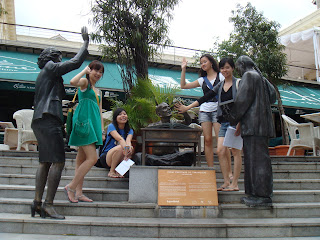Asian Civilisations Museum
 The great emporium
The great emporium
Formerly known as “Empress Place Building” (named at the start of the 20th century in honour of Queen Victoria), the building now housing the Asian Civilisations Museum had been utilised as a government office for most of its life during colonial days and even after Singapore’s independence in 1965. Designed by colonial engineer JFA McNair in the mid 1860's, it was built at a hefty sum of £53,000 by convict labour, as was a common case for many roads and buildings in Singapore during the 19th century. It was only in 2003 that the Asian Civilisations Museum was opened at this building, as one of the three museums under the National Museum of Singapore.
The history of the Singapore River in the gallery is presented as a bustling place where huge amount of trade is taking place, inferred from the congested river of old junks and boats which are highly possibly involved in trade. The hard lives of the pioneer immigrants - the ever-present coolies so often associated with the Singapore River, are also depicted through the many figurines and pictures. We see the low quality of living standards from the figurines from the dozens of coolies who live together in multi-storied squatters, each living in a cubicle that measures only slightly longer than their an average man’s body-length. The Singapore River might have been a huge port of call in the region. However, it did not necessarily equate to a highly affluent society during that period of time.
The history of the Singapore River in the gallery is presented as a bustling place where huge amount of trade is taking place, inferred from the congested river of old junks and boats which are highly possibly involved in trade. The hard lives of the pioneer immigrants - the ever-present coolies so often associated with the Singapore River, are also depicted through the many figurines and pictures. We see the low quality of living standards from the figurines from the dozens of coolies who live together in multi-storied squatters, each living in a cubicle that measures only slightly longer than their an average man’s body-length. The Singapore River might have been a huge port of call in the region. However, it did not necessarily equate to a highly affluent society during that period of time.



No comments:
Post a Comment